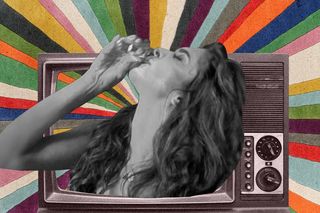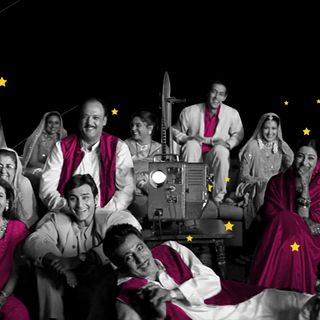
Can We Move On: From The Trope of The ‘Modern’ Girl Who Must Always Apologise For Her Life
Glamorous, vampy, torn between the motherland and the West, and a caricature of ‘modern’ values.

In Can We Move On, we revisit old tropes and question whether they have any remaining cultural relevance.
In the 2000s, the Modern Girl emerged just as Bollywood began embracing globalization and giving us real, complex women characters. She was almost always a caricature of modernity, but she was also the only real mainstream representation that progressive women had at the time.
The Modern Girl’s origins lie with the Vamp, Bollywood’s anti-heroine until the late 80s and 90s, when villainesses accessorized their malice with their glamorous attire and drinking/smoking habits. Decades of Bollywood cinema post-Independence attempted to set ‘Indian-ness’ apart from ‘Western values,’ turning the Vamp into a punching bag who’d seethe in defeat (and usually die) before the hero and the good girl went off into the sunset. But as Indians became more comfortable with these so-called western values, they didn’t need the ‘modern’ character to always be evil. So, the Vamp died out and the more amenable Modern Girl took her place. The Modern Girl didn’t inspire hatred — she was more a clueless libertine who had to come back to the right path of traditions and values. She was fashionable, beautiful, outspoken, and independent. The Modern Girl loved to party, brought vivacity to the screen, and created just the right amount of culture shock in all films’ first halves that both surprised and bewitched an Indian audience.
Yet, her modernness was always a touchy topic. If the Modern Girl was not a villain or an impediment to a love story, her Modern-ness was overturned by a sudden pivot to traditionalism — whether it’s Tina singing an aarti in the middle of her Bombay college after coming back from the U.K., or Pooja or ‘Pooh’ picking up a pooja thali to offer to her new love interest in Kabhi Khushi Kabhi Gham. However, if she was the villain, she was the free-falling libertine so enamored by her lifestyle that she simply does not know she’s crashed until it’s too late. Whether it’s Veronica in Cocktail self-destructing and facing an accident because her boyfriend wouldn’t love her back, or Shonali in Fashion developing a severe drug addiction after a wardrobe malfunction, the audience always needs to see these women either regret their modern-ness or fall apart.
The Modern Girl may be more likable, but like the Vamp, she too was a propaganda vehicle built to inspire guilt in young women who saw life beyond service to families, husbands, and children. The trope assumes that Indian women are immature, wanton children who need to be led away from a sad life of debauchery.
Related on The Swaddle:
Can We Move On? From the Mean Girl Trope As A Depiction of Hyper‑Competitiveness Between Women
The real-life modern Indian girl was a minority and existed in two clear classifications — the metro city girl and the NRI girl. Like the Modern Girl in Bollywood movies, she didn’t know how to fit in with either her traditional family struggling to hold her back, or the local/international peers who couldn’t care to wait for her. But, unlike the cigarette-and-booze-only haze of her cinematic counterpart’s life, the real-life modern Indian girl had aspirations that went far beyond her party habits. She was studying to be more — ‘outshining‘ young boys in board exams, going to college, excelling at work, and trying to solve the eternal problem of balancing employment and home.
Even though there were few of her in comparison to the total population of Indian women, the modern Indian girl was always hyper-visible. This is because society’s anxiety at women being ‘fast’ when they’re modern leads to a magnified focus on and many assumptions about women’s lives. So, the men who wrote her for the movies wrote their own interpretations of her — as women who used their bodies to get ahead at work (Corporate), as women who were silly socialites (Cocktail, Kabhi Khushi Kabhi Gham), as women whose ambitions only led them to what the audience believed was debauchery (Fashion, Page 3).
The Modern Girl existed to scare young Indian women back into their positions as dutiful, quiet wives. She existed to make them think about their reputations, pull their dupattas and pallus closer to their bodies, and to perpetually wonder what life could’ve been if they too could be brave enough to live like that. Real women may still deal with the guilt of betraying ‘traditional’ values and lead double lives hidden from their families, but they know they’re not wrong to want their own choices, independence, and happiness. This change in perspective also shows in how parts of mainstream Bollywood depicts its heroines now. From films like Manmarziyan, Queen, Dear Zindagi, Tamasha, and shows like Lust Stories, Four More Shots, Aarya, and Made in Heaven, “The Hindi film heroine has finally lost the burden of being good,” says actress Swara Bhasker in the Hindustan Times.
The Modern Girl rests in peace, awakened once in a while by one or ten Bollywood potboilers stuck in the last decade. As more women write films and as more women characters have layers built into them, the new heroine’s greatest problem isn’t always whether she’s traditional enough. The real modern Indian girl needn’t grasp on to The Modern Girl for representation now — she doesn’t always get exactly what she wants, but she hardly has slim pickings anymore.
Aditi Murti is a culture writer at The Swaddle. Previously, she worked as a freelance journalist focused on gender and cities. Find her on social media @aditimurti.
Related


The Buzz Cut: Some Reasons Why Family Time in India Is So Fraught
